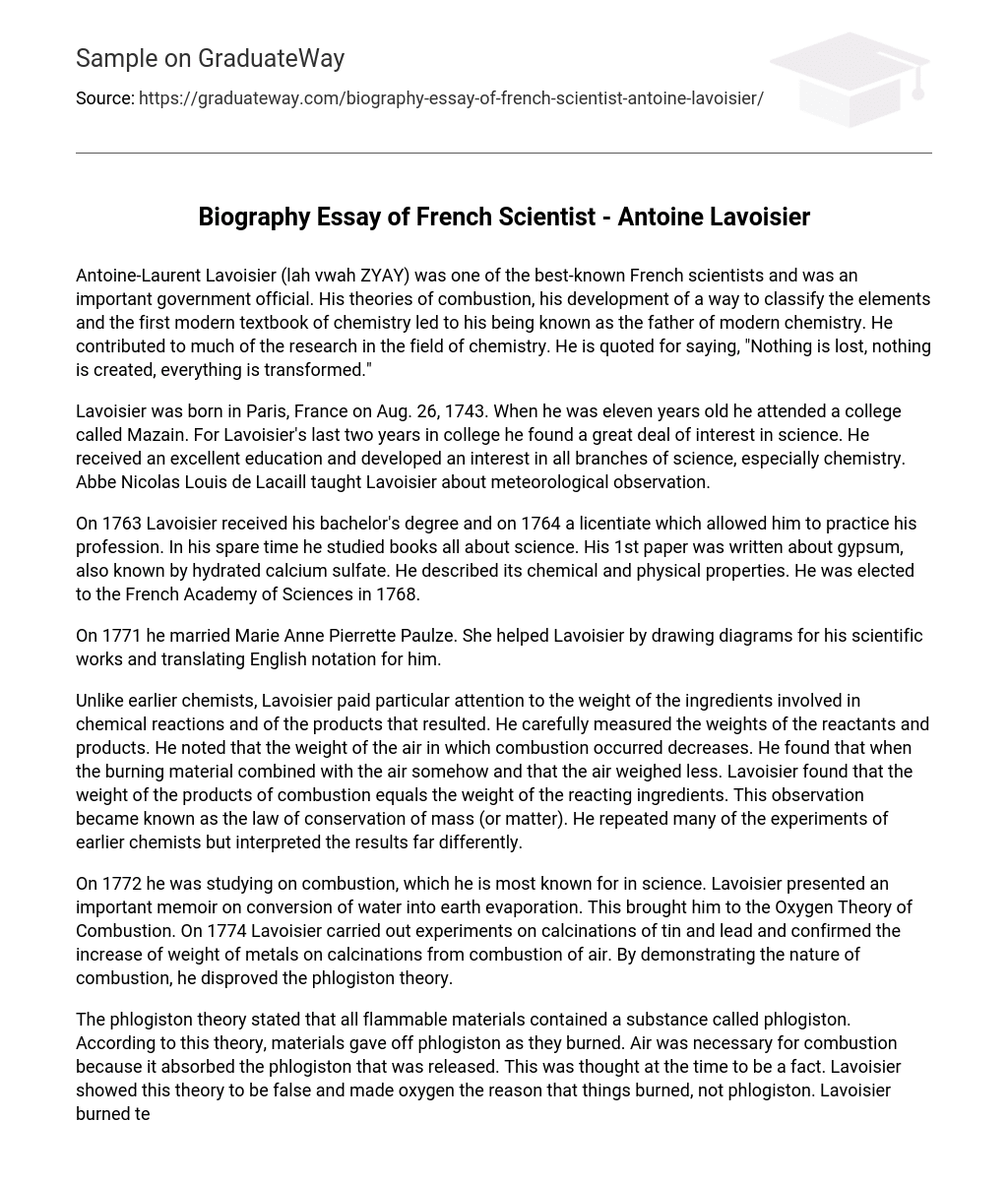Antoine-Laurent Lavoisier (lah vwah ZYAY) was a renowned French scientist and influential government official. He gained recognition as the father of modern chemistry due to his theories on combustion, innovation in element classification, and authorship of the first modern chemistry textbook. Lavoisier made significant contributions to the field of chemistry and is famously quoted for his belief in the conservation of matter: “Nothing is lost, nothing is created, everything is transformed.”
Lavoisier was born on Aug. 26, 1743 in Paris, France and began his studies at Mazain college when he was eleven years old. He developed a strong interest in science, particularly chemistry, during his final two years at college where he received a comprehensive education in all scientific fields. Abbe Nicolas Louis de Lacaill played a significant role in teaching Lavoisier about meteorological observation.
In 1763, Lavoisier obtained his bachelor’s degree and in 1764 he earned a licentiate, which allowed him to practice his profession. In his leisure time, he devoted himself to studying different scientific books. His first research paper centered on gypsum, also known as hydrated calcium sulfate, and included an analysis of its chemical and physical properties. Subsequently, in 1768, Lavoisier was accepted into the French Academy of Sciences.
Marie Anne Pierrette Paulze married Lavoisier in 1771 and provided invaluable assistance by creating diagrams for his scientific works and translating English notation.
Unlike previous chemists, Lavoisier focused on the weight of the substances involved in chemical reactions and the resulting products. He meticulously measured the weights of both the reactants and products. He observed that the weight of the air decreases during combustion. Lavoisier discovered that the burning material somehow combined with the air, causing the air to weigh less. He also determined that the weight of the combustion products is equal to the weight of the reactants. This observation became known as the law of conservation of mass (or matter). Lavoisier replicated many experiments conducted by earlier chemists, but interpreted the outcomes differently.
In 1772, Lavoisier’s studies focused on combustion, which became his most famous scientific contribution. This led him to develop the Oxygen Theory of Combustion after presenting a significant memoir on the conversion of water into earth evaporation. Two years later, in 1774, Lavoisier conducted experiments on the calcinations of tin and lead. These experiments confirmed the weight increase of metals during calcinations due to the combustion of air. Through his demonstrations on the true nature of combustion, Lavoisier was able to disprove the phlogiston theory.
The belief that all flammable materials contained a substance known as phlogiston was known as the phlogiston theory. This theory claimed that materials released phlogiston while burning, and that the presence of air was crucial as it would absorb the released phlogiston. It was widely accepted as true during its time. However, Lavoisier disproved this theory and identified oxygen as the actual cause of combustion, as opposed to phlogiston. In an attempt to invalidate the phlogiston theory and assert oxygen as the new explanation for combustion, Lavoisier burned textbooks that supported the erroneous belief in phlogiston.
The foundation for comprehending chemical reactions as the amalgamation of elements to create new substances, or products, was established by him. His conclusion was that combustion is the result of the swift chemical fusion between a combustible material and a recently discovered gas, which he termed “oxygen”, previously known as “dephilogisticated air”. The term “oxygen” denotes acid production. Lavoisier and other scientists had observed that oxygen is a component of various acids. Erroneously, Lavoisier inferred that oxygen is required for the production of all acids. He devised prefixes for indicating the level of oxygen by affixing specific endings such as -ic or -ous.
French astronomer and mathematician Pierre Simon Laplace and Lavoisier conducted experiments on animal respiration, finding a resemblance between regular chemical reactions and physiological processes. Their findings served as the foundation for biochemistry. Additionally, Lavoisier played a key role in creating a nomenclature system for chemicals that is still utilized today.
He authored the Traité elémentaire de chimie (Elements of Chemistry), widely regarded as the inaugural modern chemistry textbook. It introduced a systematic approach to categorizing elements and featured numerous compounds that were then believed to be elements. Additionally, Lavoisier formulated chemical equations that adhered to the principle of mass conservation.
In his capacity as a government official, Lavoisier accomplished success in multiple domains. These included implementing agricultural reform, acting as a tax collection official, and supervising the government’s gunpowder production. One of his notable achievements was being appointed as the commissioner of gunpowder in 1775. This role involved improving the quality of French gunpowder and greatly advancing his career.
Lavoisier, a moderate constitutionalist, was disliked by radicals like Marat because of his political beliefs. He joined the Ferme Generale, a tax-collection firm that became a target during the Terror. When the Reign of Terror began in France, Lavoisier fell victim to its tyranny and lost his life as one of France’s greatest scientists. In 1793, he was arrested by leaders of the French Revolution and despite his significant achievements, found guilty of conspiring with France’s enemies due to his involvement in tax collection. On November 24th, 1793, Lavoisier and his 27 colleagues were executed by guillotine.
Bibliography:
http://www.english.upenn.edu/~jlynch/FrankDemo/People/lavois.html
1999 edition of the World Book Encyclopedia
Here is the website for Antoine Lavoisier’s profile: http://www.dupont.com/corp/science/lavoisier/antoine.html





